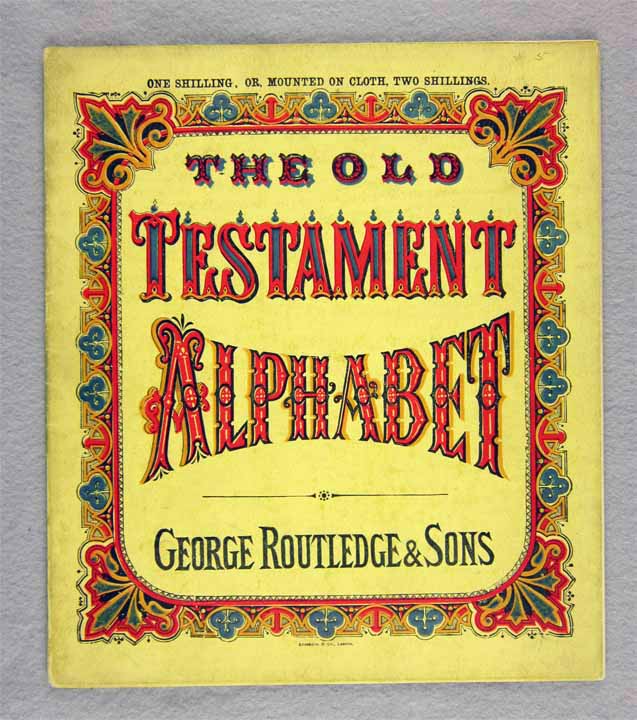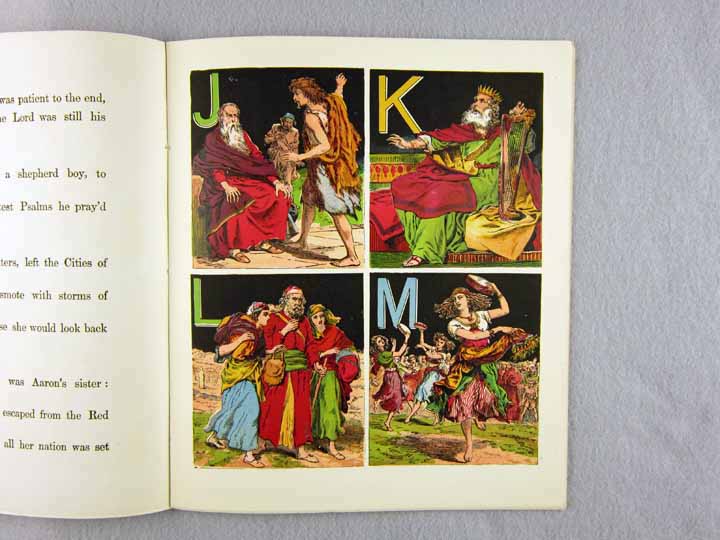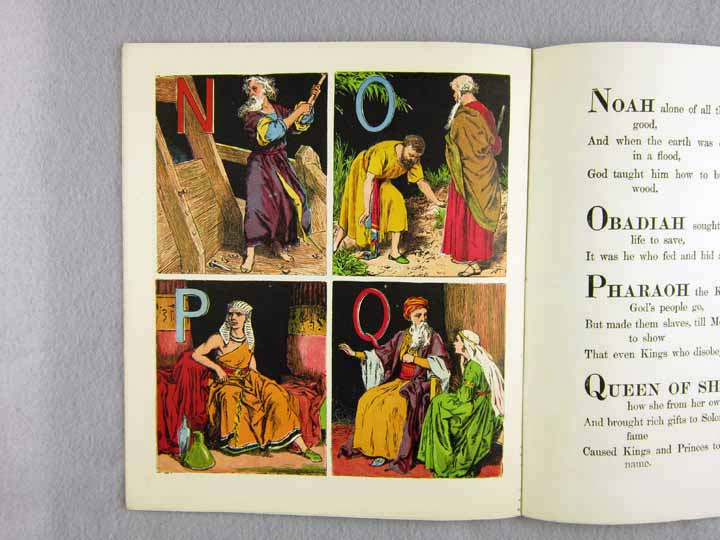

Alphabet books offer a vivid insight into the history of literacy and culture, as well as concepts of childhood. The Children's Book Collection at UCLA contains a rich array of these materials, some well-worn and much-used, some still bright and fresh. Each is a gem of print production and graphical imagery from another time and place. Though the history of alphabet books continues to the present, this exhibit focuses on the works in our collections published between 1700 and 1900, including horn books, primers, works of didacticism and seriousness, whimsy and play.
2. A Jumble ABC
3. A Little Pretty Pocket-Book
4. A New Lottery Book of Birds And Beasts
5. A Pretty Play-Thing for Children of All Denominations
8. ABC of Objects for Home And School
10. ABC with Pictures & Verses
12. Alphabet Et Instruction Pour Les Enfans
16. Dolly's ABC Book
17. Flora's ABC
18. Home ABC
22. Hornbook C. 1700
23. Large Letters for the Little Ones
24. Little ABC Book
25. Little People: An Alphabet
26. Martin's Nursery Battledoor
27. Mother Goose ABC
28. My Darling's ABC
29. Orbis Sensualium Pictus Quadrilinguis
30. People of All Nations: A Useful Toy for Girl Or Boy
31. Picture Alphabet
32. Pretty ABC
33. Railway ABC
34. Rusher's Reading Made Most Easy
38. The Alphabet of Old Friends
40. The Amusing Alphabet for Young Children Beginning To Read
42. The Child's Christian Education
45. The Easter Gift
47. The Favorite Alphabet for the Nursery
49. The Franklin Alphabet And Primer
51. The Golden ABC
55. The Moral And Entertaining Alphabet
57. The Old Testament Alphabet
59. The Picture Alphabet for Little Children
62. The Sunday ABC
63. The Union ABC
64. The Young Child's ABC, Or, First Book
65. Tom Thumb's Alphabet: Picture Baby-Books
67. Warne's Alphabet And Word Book: with Coloured Pictures
68. Wood's Royal Nursery Alphabet
Title The Old Testament Alphabet



Brief description This vividly colored alphabet book associates each letter with a biblical name or moral. The cover is composed of printed yellow wrappers; decorative border on upper wrapper in black, red, blue, and yellow. When originally published, the book cost one shilling, or, mounted on cloth, two shillings.
Full description The rhyming text of this book links biblical stories to the alphabet through Old Testament names. The book's illustrations prominently feature a letter surrounded by a related biblical figure or vignette. These textual and visual connections associate the alphabet with religion, linking the processes of religious and alphabetic literacy.
Literacy The book promotes religious literacy, using the alphabet as a didactic tool to reinforce the moral lessons of biblical literature. The book is designed for a child who has already mastered the basic skills of alphabetic literacy and understands the relationship between sound, letter, and word. The text of the book features complex sentences with higher level vocabulary, assuming that book will be read to a child by an adult or that the child will possess a high level of reading comprehension. The images for each letter are not adjacent to the correlating text. This requires the reader to process the text, and then match the expressed concept with one of the images. This matching can occur by recognizing the emphasized letter within the text, which is the initial letter of a bolded biblical name, and then finding the same letter shape within the images. The process reflects a fundamental type of alphabetic literacy. However, the matching can also occur by recognizing the biblical name, whether read or heard, and then matching that name with the visual characteristics in each image. This type of matching requires a high level of religious literacy in order to recall the attributes of a given biblical figure and identify that figure within an image. In this way, The Old Testament Alphabet connects the task of learning the alphabetic code with the process of biblical education, tying together reading and religion into a single educational framework.
Childhood This book uses the alphabet to teach children biblical narratives and reinforce the relationship between literacy and religion. The multi-syllabic words of the text indicate that the book is designed for older children. The book deals with the violent stories of the Old Testament by transforming them into moral lessons that depict God as a savior for those who deserve his grace. In the tradition of 17th century Enlightenment philosopher John Locke, these lessons assume that the child is a "tabula rasa," or blank slate, that is receptive to reasoning. The book uses biblical figures to demonstrate how righteous actions can lead to worldly and spiritual rewards, while sinful actions lead to punishment. The association between the alphabet and biblical figures is also important within a Puritan framework that emphasizes the necessity of literacy as a means of having a personal relationship with God. Only one child is pictured in the text: J is for "Young Joash, when a little child, was hidden from the sight, Of those who sought to slay him, and was kept both day and night, Till priests and captains claim'd for him his own true kingly right". The illustration depicts a woman protectively holding a small, idyllic-looking infant. This image reinforces the idea that childhood is a vulnerable time during which children should learn reason and religion in order to become productive members of society.
Iconography This book uses the religious topic to depict exotic iconography. The book is visually rich with vibrantly colored illustrations. The vividness of the illustrations is coupled with the use of ethnic figures and exotic locations to make the well know subject of Old Testament stories and morals more engaging. The book depicts palm trees and desert landscapes, visualizing the true geographic location of the Bible. "P is for Pharaoh," shows an Egyptian Pharaoh headdress. These images create a larger worldview and an idea of exotic geography and history. Other ethnic groups are also portrayed in the text. For example, the image that accompanies, "M for Miriam the prophetess, . . . who led the Jewish women to dance and sing in joy," shows a group of dancing women in brightly colored garments with large jewelry and dark, curly hair. These images display a desire to eroticize other ethnic groups by placing them in a geographically and chronologically distant space rather than acknowledging present realities. The cultural iconography in the book invites the reader to fantasize about the ethnic other.
Production George Routledge & Sons published The Old Testament Alphabet in London sometime after 1870. George Routledge, a London bookseller, began a publishing company with his brother-in-law in 1851. The publishing company specialized in children's books, adventure stories, moral works and fairytales. This book is composed of six sheets of paper, three printed with text on a single side and three printed with illustrations on a single side. The six sheets are folded in half and sewn together with three simple stiches. This format creates multiple blank pages throughout the book, but was much easier to produce because two large sheets of paper could be printed, one of type and the other of illustrations. The two sheets could then be cut into pages and sewn together. Though this part of the production process was less labor-intensive, the vivid color illustrations in the text were time consuming to produce. The illustrations were produced through a process of chromolithography, a form of colored printing developed during the nineteenth century. In chromolithography, a new lithographic stone is need for each color in the illustration. This means each additional color added to the illustration requires another pass through the printing press. George Routledge & Sons could have used a less time consuming method of production in order to afford the vibrant chromolithographs in this book.
Publisher George Routledge & Sons:Kronheim & Co.
Publication place 42 Skinner Street, London
Date 1870
UCLA Call Number CBC * GR486 .O43 1870
Repository UCLA Charles E. Young Research Library, Dept. of Special Collections
Dimensions 27 cm, height
Technologies of production Chromolithography
Media and Materials Paper
Caption